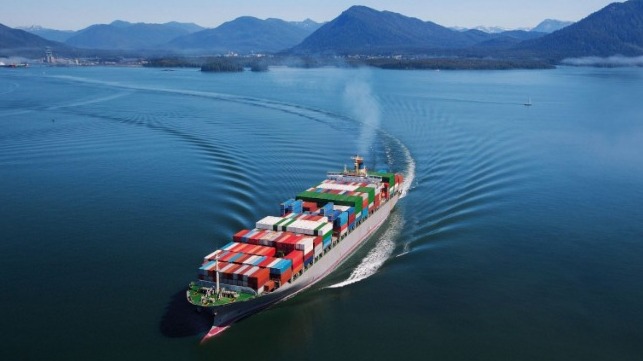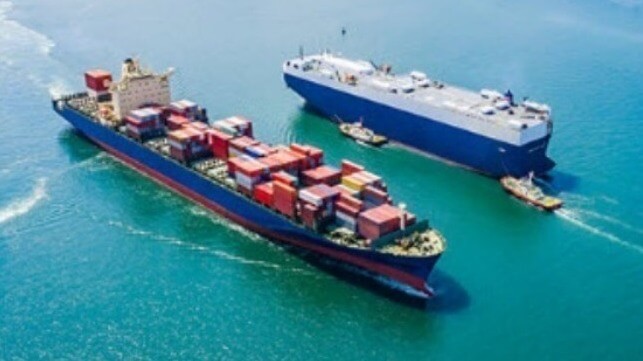Report Zero-Emission Fuels Could Add 50% to Container Shipping Costs

The early moves both among the container carriers and the shippers face substantially higher costs for transporting containers using the new generation of zero-emission vessels and fuels. A new report from independent UK consultancy UMAs seeks both to quantify some of the potential costs and contribute to the discussions by highlighting the challenges that lay ahead for the industry, echoing similar concerns raised by industry CEOs attending the current COP 28 conference and other reports that highlight the potential near-term shortages in the supply of alternative fuels.
“The role of the early movers including cargo owners, and their willingness to pay is therefore vital in setting up a zero-emissions shipping market,” writes UMAS. “This report contributes to that dialogue by providing examples of baseline additional cost per container required to bridge the cost gap considering only technological savings. It shows the room that cargo owners, governments, and other stakeholders have to contribute.”
UMAS used a variety of models to estimate the costs that will be incurred concluding that they could add as much as half to the current price of moving boxes on some routes. Initially, the report predicts there will be a significant cost gap between conventional fossil fuels and scalable zero-emission fuels. For example, in 2030 on the transpacific route, under the best-case fuel price scenario, the cost difference can be $150 per TEU for green ammonia, $210 per TEU for green methanol, and as high as $350 per TEU for green ammonia and $450 per TEU for green methanol in a high fuel price scenario. The lowest cost they find would be $90 per TEU transpacific and even on a Chinese coastal route could range between $30 and $70 per TEU.
The fuel cost gap is now acknowledged as the main blocker for shipping’s transition and tackling it requires a frank conversation about the dimension of the challenge,” said Camilo Perico, Consultant at UMAS, and author of the report. “We need “numbers on the table” and more visibility on how stakeholders can help to cover it.
The report details significant financial burdens, especially for the early adopters which will be needed to move the market forward. The industry has cited these same concerns. The CEOs of five leading carriers last week called for regulatory efforts and a move to level the cost difference between traditional and alternative fuels spreading the premium across all fuels.
UMAS calculates that a vessel operating transpacific would require an additional $20 to $30 million annually by 2030 when you consider both the capex investment in the vessels and operational expenditure. Fuel they highlight would be $18 to $27 million of the added annual cost.
Early adopters will have some choices according to UMAS which will also have an impact on the market. They could go with cheaper but non-scalable fuels such as the much-touted bio-methane, which they conclude will however become more expensive as demand outstrips supply. The alternative will be to invest in fuels with a higher capital expense but it would stimulate the market and become less expensive as production ramps up. UMAS expects that the cost gap will not narrow until 2050.
“The analysis shows fuel costs are a major component of the overall cost and therefore the primary driver of the total cost of operation. With the right demand signals and corporate action during the emergence phase, production and supply of zero-emission fuels and freight services can make a head start in lowering the cost gap that this work has shown,” said Dr. Nishatabbas Rehmatulla, Principal Research Fellow at UCL and co-author of the report.
They are calling for increased dialog and using the data to help plan the long-term approach for the shipping industry. The report notes that there are already emerging subsidies that could close the gap between conventional fuels and the new scalable alternatives. They highlight the regulatory efforts in the EU and U.S. that have the potential to help cover the cost difference on specific routes as well as future initiatives such as programs in the UK and Norway that would specifically support hydrogen fuels.
UMAS concludes that the window of opportunity for corporate action before regulation increasingly closes the gap is only available for a few years. The full report and the analysis are available online to help guide the discussion and the decision that the shipping industry needs to undertake.
Why Clean Shipping Fuels Need Solar-Industry Style Support

Shipping receives nowhere near the media coverage given to aviation, yet the sector also accounts for around three percent of global energy-related carbon dioxide emissions. Its footprint must be tackled rapidly if international climate targets are to be met. Solutions to decarbonize shipping exist, most notably in the form of green methanol, and some shipping firms are investing heavily in a greener future. However, the regulations and financial support needed to scale up the sector and push down costs are still found wanting.
The wind and solar industries are today mainstream players in the power sector. Costs, in particular for solar, have fallen massively everywhere. However, this positive trend would not have happened without significant government backing as these industries were starting out. The shipping industry has been used to accessing cheap fuels and, without similar financial and legal assistance, cleaner shipping fuels will remain an expensive pipe dream.
The shipping sector must reduce its emissions by 45 percent by 2030 compared with 2010 to come in line with the Paris Agreement commitment to keep global heating below 1.5°C above pre-industrial levels, says the Copenhagen-based Mærsk Mc-Kinney Møller Center for Zero Carbon Shipping, a not-for-profit research center. Meeting this target will be challenging, but the technology to achieve it exists and companies are engaging with the transition.
First, the technology. Methanol is a chemical compound that has long been in great demand for a variety of industrial applications. It is a relatively benign substance and, as a light liquid, it is easy to transport and store at room temperature. Almost all methanol today is, however, produced from coal and natural gas. Green methanol, on the other hand, is generated from clean energy sources either as bio-methanol or e-methanol. Bio-methanol can come from biogas or the gasification of sustainable biomass sources like agricultural and forestry residues and municipal waste, while e-methanol is produced from green hydrogen from renewable electricity and captured carbon dioxide.
Danish company Maersk has leapt ahead of global regulatory requirements through a commitment to procure only vessels compatible with green fuels and is taking steps towards retrofittings. As part of this transformation, the company has ordered 25 green methanol vessels it expects to come into service in the next three to four years. These decisions will help drive the creation of new green methanol supply chains as Maersk develops extensive off-take partnerships with energy companies.
Maersk is not the only company changing the way it does business. The global order books for low emissions vessels grew six-fold from 2019 to 2022 and changes to bunkering and fuel supply are also beginning to happen. In 2016, there were almost no shipping ports planning green fuel bunkering; by the end of 2022, ports representing around 16 percent of global shipping volume had announced plans to build out green fuel bunkering.
Green methanol supply has also been growing rapidly with total global production capacity increasing by 450 per cent from 2020 to 2023. This figure may sound impressive, but it comes from a very low base. Today, there are less than 0.2 million tonnes of green methanol on the market; we need at least 20 million tonnes by 2030. Further, production costs remain high, leaving large numbers of projects stuck in early-stage development. They will remain there unless we can secure long-term offtake at a price that makes these projects viable — but shipping companies cannot simply pass all of these higher costs to the owners of the cargo they move.
Governments can help solve this affordability gap between the cost of production and customer willingness to pay through "demand pull" initiatives, like the mandates for green hydrogen in the EU’s Fit for 55 package. Such policies create a clear demand signal and the industry can examine how to meet that at the lowest cost. We also need "supply incentives" like the EU's Hydrogen Bank and the US Inflation Reduction Act to help bridge production cost gaps.
Corporate leaders surveyed for Global Corporate Stocktake carried out by We Mean Business, with support from the UN Climate Champions team and consultancy Bain & Company, ahead of the COP28 climate summit, cited the lack of infrastructure to support fuel production and bunkering, commercial constraints and uncertainty surrounding technology pathways as important blockages to system change in the shipping industry. They also emphasized the need for governments to support collaboration between different actors in the shipping sector to push initiatives like "green corridors" where low-emissions vessels are incentivized.
Ultimately, green methanol will not be the only solution to decarbonize shipping. In the coming years, other low-emission fuels, like ammonia, are likely to come onto the market, with the end result being a complementary patchwork of solutions. For the moment, though, governments, and industry, should be focused on green methanol as a proven, easy-to-use solution that, with the right support, can be scaled up immediately.
Brian Davis is CEO of C2X, a standalone company founded by A.P. Moller Holding (APMH) and its shipping arm Maersk to "defossilize" the fuel used by shipping.
The opinions expressed herein are the author's and not necessarily those of The Maritime Executive.
Report: Financial and Regulatory Barriers Delay Zero-Emission Fuel Supply

Zero-emission fuels such as methanol and ammonia are an important focus in the efforts to reach the shipping industry’s decarbonization targets, but a new report highlights that leaders across the industry believe financial and regulator hurdles are slowing the developments. Presented as a perspective on how to start addressing the barriers affecting zero-emission fuel projects, the report calls for unconventional partnerships and business models supported by regulatory and financial collaborations to overcome the barriers to lay the foundations for a zero-emission future in shipping.
While there has been a lot of publicity and discussion about these zero-emission fuel projects, the report concludes that “more than 95 percent of the projects centered on producing these fuels have not yet passed the final investment (FID) phase.” They highlight that this is despite the rising demand for the fuels as indirectly indicated by the more than 180 dual-fuel ships already on order and more planned.
“We are in the middle of what needs to be the decade of action if maritime shipping is to achieve net-zero emissions by 2050,” writes Mette Asmussen of the World Economic Forum and Peter Jonathan Jameson of Boston Consulting Group in the forward of their new report. “We need to eliminate these emissions through scaling of technologies that can power deep-sea vessels.”
Despite the positive momentum, the report highlights that the shippers and carriers that helped to launch the First Movers Coalition for shipping in 2021 are saying that barriers in the maritime value chain and beyond are hindering decarbonization from progressing at the speed needed.
Interviewing industry stakeholders, the report highlights that the nexus between demand and supply is an important dynamic and will help to increase the confidence to invest in the supply side. The interviews with more than 20 stakeholders shed light on the barriers that they believe are holding back the investment decisions and progress that is required.
Ten barriers were identified as limiting the projects from getting past the key FID milestone. The report categorizes the barriers into segments including customer and consumer demand, economic and financial issues and regulatory, as well as supply chain and infrastructure challenges and organizational issues within the companies. They point to issues such as the “green premium” and the lack of clear signals and willingness to cover the costs as well as the gap in offtake agreements and the lack of credible cost estimates.
Existing financial instruments and funds they also conclude are “not fit for purpose in terms of horizons and risk appetite.” At the same time, they point to a lack of near- and mid-term mandates or a global carbon price. Finally, they point to infrastructure issues for the storage and transportation of e-fuels.
The report concludes that while collaborations are underway to overcome the barriers, more needs to be done to get the first movers to take bold actions to advance the development of alternative fuels. “Although daunting, these barriers need not all be overcome simultaneously,” the report asserts.
They call for steps in addition to the support of green corridors that can consolidate shipping’s demand for methanol and ammonia with other sectors to hedge end-market risk. They also see the need to drive offtake agreements suggesting steps including reverse auctions using public-private demand aggregation.
The report also calls for using innovative contracting and financing mechanisms. They suggest that steps such as capacity payments, dynamic contract pricing, and offering equity stakes to strategic buyers could help to overcome the current financial challenges.
The report follows on from a statement last Friday, December 1, by five of the CEOs of the largest shipping companies highlighting the challenges they see in meeting the decarbonization objective. Their message called for greater collaboration and regulator efforts to support the industry during this period of transition.
No comments:
Post a Comment